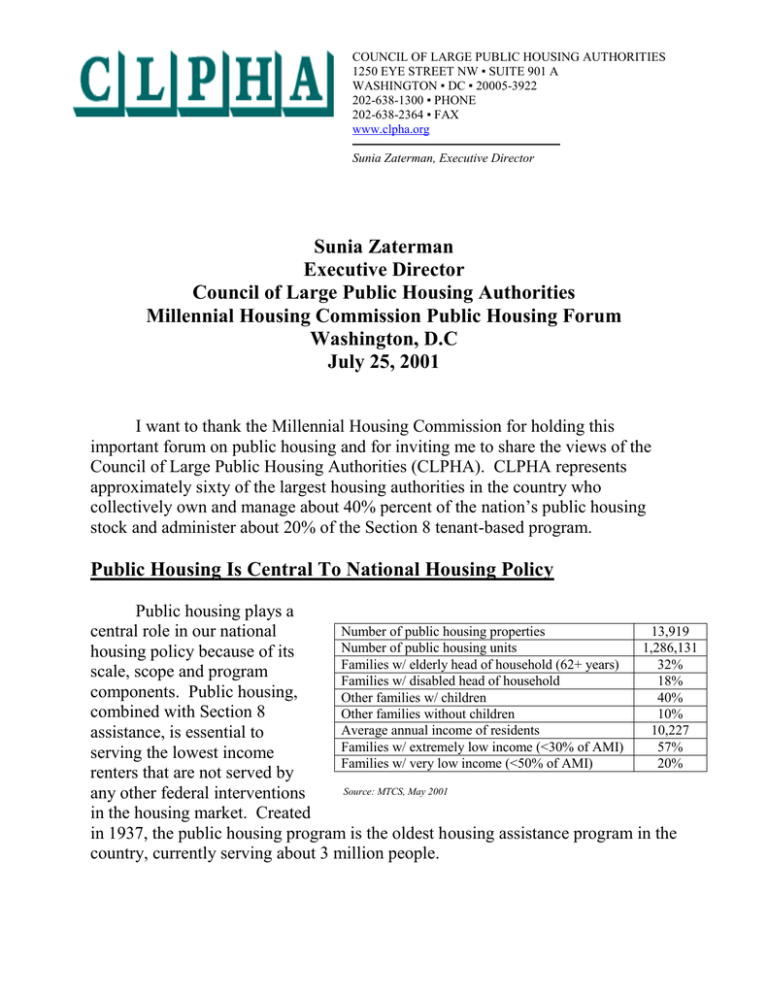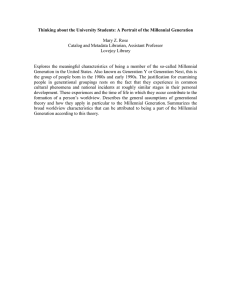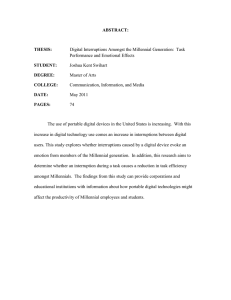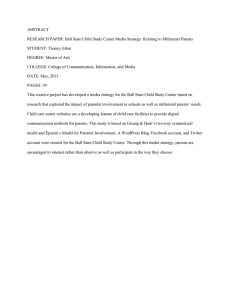Document 15584985
advertisement

CLPHA Millennial Housing Commission Public Housing Forum July 25, 2001 Page 1 COUNCIL OF LARGE PUBLIC HOUSING AUTHORITIES 1250 EYE STREET NW ▪ SUITE 901 A WASHINGTON ▪ DC ▪ 20005-3922 202-638-1300 ▪ PHONE 202-638-2364 ▪ FAX www.clpha.org Sunia Zaterman, Executive Director Sunia Zaterman Executive Director Council of Large Public Housing Authorities Millennial Housing Commission Public Housing Forum Washington, D.C July 25, 2001 I want to thank the Millennial Housing Commission for holding this important forum on public housing and for inviting me to share the views of the Council of Large Public Housing Authorities (CLPHA). CLPHA represents approximately sixty of the largest housing authorities in the country who collectively own and manage about 40% percent of the nation’s public housing stock and administer about 20% of the Section 8 tenant-based program. Public Housing Is Central To National Housing Policy Public housing plays a Number of public housing properties 13,919 central role in our national Number of public housing units 1,286,131 housing policy because of its Families w/ elderly head of household (62+ years) 32% scale, scope and program Families w/ disabled head of household 18% components. Public housing, Other families w/ children 40% combined with Section 8 Other families without children 10% Average annual income of residents 10,227 assistance, is essential to Families w/ extremely low income (<30% of AMI) 57% serving the lowest income Families w/ very low income (<50% of AMI) 20% renters that are not served by Source: MTCS, May 2001 any other federal interventions in the housing market. Created in 1937, the public housing program is the oldest housing assistance program in the country, currently serving about 3 million people. CLPHA Millennial Housing Commission Public Housing Forum July 25, 2001 Page 2 Over the last 60 years, we have witnessed the creation and demise of many federal housing programs and the crisis of privately owned housing opting-out of subsidy programs. We would be well served by understanding the aspects of public housing that have sustained it over this remarkably long period of time. The intent of public housing is to ensure the availability of affordable housing in perpetuity so that the public investment is protected and affordable housing continues to serve as a community asset. Even with the vicissitudes of policies, politics and funding, the demand for public housing far outstrips the supply in virtually every major metropolitan area in the country. Public housing has the most direct delivery system of funding, developing and operating low income housing: a development grant, operating subsidy and capital grant. As we know, the operating subsidy is a key component in serving households in the greatest need. In light of the demand for public housing, we ask that the Millennial Housing Commission consider the following recommendations in formulating the Commission’s report to Congress. Preservation and Capital Investment Preservation, revitalization and capital investment are essential to protecting the enormous public asset that public housing represents. The most recent study of modernization needs in public housing cites an unmeet need for capital investment of $22 billion, more than five times the backlog amount for privately owned assisted housing. (Public housing developments are older, historically underfunded and without provision for ongoing replacement reserves.) We must aggressively pursue cost effective and efficient ways to accelerate capital improvements in public housing, such as: 1. Streamline and expedite HUD approval of private sector lending. 2. Open access to a wider range of existing financing mechanisms for public housing. 3. Develop a public housing credit enhancement or loan guarantee mechanism to reduce the cost of financing. 4. Facilitate pooled loans or bond issues. 5. Fund a replacement reserve. CLPHA Millennial Housing Commission Public Housing Forum July 25, 2001 Page 3 Expand Principles of the Moving to Work Demonstration Moving to Work (MTW) is a demonstration program that allows housing authorities to design and test ways to: achieve programmatic efficiency; deploy three funding sources interchangeably as a block grant; reduce costs; increase housing choice for low-income households; and promote self-sufficiency among assisted families. To permit the flexibility needed for this type of innovation, Congress exempted participating housing authorities from the statutory provisions of the Housing Act of 1937 and associated HUD regulations to the extent delineated in an MTW agreement between HUD and each housing authority. The purposes of the demonstration are to: develop more effective strategies for managing public housing and tenant-based housing assistance; replicate those strategies after the demonstration; and achieve self-sufficiency among assisted families. While most demonstration sites are focused on specific aspects of administration such as rent policies, there are a number of large housing authorities that are implementing authority-wide changes in operations, finance and development. Even in the early stages of the demonstration, we are very encouraged that the combination of regulatory flexibility and more stable funding can significantly improve the effectiveness of these housing programs. Key principles of the demonstration include: 1. Fungibility of resources including public housing operating and capital fund and Section 8 assistance. 2. Tailoring use of fungible resources to local housing needs and market conditions. 3. Long term strategic planning based on stable funding. 4. Regulatory relief that allows housing authorities to play a key role in city-wide housing solutions such as FHA dispositions, special needs housing and assisted living. CLPHA Millennial Housing Commission Public Housing Forum July 25, 2001 Page 4 Housing Production There is widespread and bipartisan consensus that an affordable housing production initiative targeted to low income households is needed, but what form it will take and the source of funding are still being debated. The Commission’s findings will be critical in shaping this crucial debate. It is critical that any new production program designed to meet the needs of very low-income residents provide direct funding to units of local governments, specifically housing authorities. As some of the greatest housing needs are in urban areas, it is paramount that localities be given first access to any production resources. We recommend the following: 1. Provide full and direct access for housing authorities to development funds that takes advantage of their far-ranging powers permitting them to play a variety of roles such as developer, partner, land owner and asset manager. Note that the 1998 Quality Housing and Work Responsibility Act (QHWRA) ushers in a new era of wide-sweeping reforms in public housing. The Act enables PHAs to serve a more socially balanced community, allows for more entrepreneurial activity and provides new flexibility in modes of development. 2. Use public housing waiting lists for new units produced under this initiative. 3. Repeal the Faircloth amendment restricting the production of new low-income units. 4. Make Sec 8 project-based assistance sufficiently flexible as a development tool. Wider use of project-based assistance can mitigate utilization concerns. 5. Site and neighborhood standards should support revitalization strategies. Elusive and often out-dated deconcentration and mobility strategies should not inadvertently starve neighborhoods that can be revitalized with infusions of capital. 6. Income mixing is critical and flexibility in implementation is needed because of the variation in housing need and market conditions across the country. 7. Provide for hard replacements units lost in HOPE VI redevelopment. While units being demolished at HOPE VI sites are obsolete and in many cases longterm vacant, they represent a significant loss to the overall supply of affordable housing. The operating subsidy and capital allocation for demolished units should be preserved for use in other development initiatives. CLPHA Millennial Housing Commission Public Housing Forum July 25, 2001 Page 5 Oversight, Monitoring and Assessment HUD’s oversight and monitoring of public housing requires a complete overhaul shifting from a focus on process and complicated regulatory structures to outcomes and effective asset management. Needless and expensive regulatory intrusion hinders good performance. The following recommendations are essential to the future successful operation of public housing: 1. Reorganize HUD and its oversight of public housing to reduce costly regulatory burdens and focus on asset management. 2. Establish an independent third party accreditation system, as health and education industries do, to improve performance while setting meaningful industry standards. (See attached reports on accreditation.) Attachments: Accreditation in Public Housing: A Call for a Study, April 1997 Feasibility Study on the Establishment of a Public Housing Accrediting Board, October 1997 Standard Setting for Public Housing Authority Accreditation, July 1998




